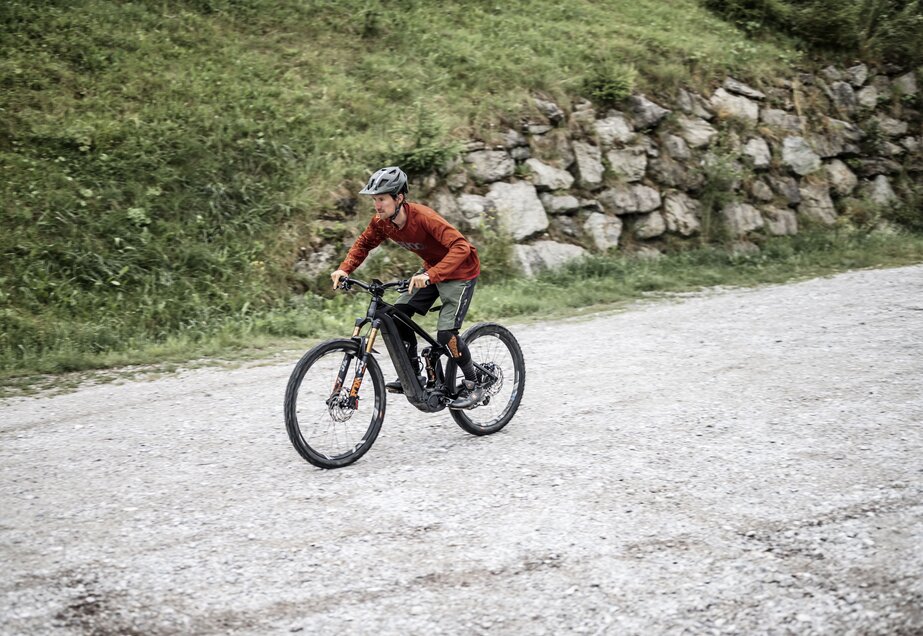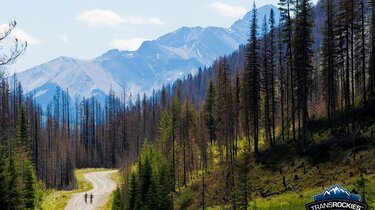

MTB technique – tips, tricks, drills and exercises
Helpful tips and simple exercises for improving your MTB riding technique – so you’ll stay safe when you’re hitting the trails!
Tipps, tricks and exercises for improving your riding technique
Mountain biking isn’t an easy sport, and you don't learn how to properly ride a bike overnight ... Anyone who wants to master tricky root passages, blaze through narrow bends or tackle steep climbs needs the right riding technique. That’s why we have compiled helpful tips and tricks as well as simple exercises and drills for beginners and mountain bikers who want to finetune their riding skills. With these, you’ll be able to safely ride your MTB off-road – and keep having fun on the trails!
Base position
Base position
The correct base position is essential when it comes to mountain biking. All additional riding techniques are based on this position. Here’s what it looks like:
- The pedals are horizontal.
- Your centre of gravity is right above the bottom bracket.
- Your arms and legs are slightly bent and relaxed.
- Your elbows are pointing outwards – this is also called the "gorilla posture".
- You keep your upper body flat with your back being almost horizontal.
- Your index fingers rest on the brake levers.
- Direct your gaze forward onto the route (about two seconds ahead).
- Low in the front, high in the back: Your legs are more extended than your arms.
The motto while riding is: "Heavy feet, light hands". So make your feet heavy! This lets you control the bike a lot better! And when a passage gets a little trickier, don't clench the handlebars until you get “white knuckles”. Otherwise, you could easily lose your balance on the bike.
The 3 biggest mistakes:
- Extended arms usually mean that the rider is in a kind of "anxiety position". The problem: You can hardly exert any pressure on the front wheel, and manoeuvring becomes more difficult.
- X-knees: This knee position makes it more difficult to move the bike.
- When you bend your knees, you shift your centre of gravity forward: This blocks movement, and your hip will be positioned incorrectly.
Good to know: On steep descents, you need to shift your centre of gravity towards the back – or you need to push the bike forward underneath you as you transition from flat to steep terrain. The centre of gravity always has to be in line with the terrain.
Balance
Riding off-road means: You’re riding uphill and downhill, over roots and rocks. Sometimes it gets steeper, and in between there are narrow bends. So having a good sense of balance is essential and thus one of the basic skills when riding a mountain bike.
With these riding technique drills, you can improve your balance:
- Wedge your front wheel against a wall and try to keep your balance.
- Prop up your front wheel on a smaller obstacle (e.g. a tree stump).
- Shift your centre of gravity forward as you lean into a slight incline while balancing. Pedal pressure is important here. (Caution: This tends to be difficult for beginners!)
- Keep your balance on flat terrain, with the front wheel turned inwards.
In addition to these exercises, there are a few other ways to improve your balance: You can also try these exercises one-handed, free-handed, sitting, standing or with a straight front wheel. It is important to repeat the exercises several times to get a feel for the bike.
Braking correctly
You’ve rehearsed the base position and already know how to shift your weight? Then the correct off-road braking technique can follow. Put one finger on each brake lever and apply the front and rear brakes simultaneously. This gives you a stronger braking effect and thus a shorter stopping distance.
Front brake
The front brake is much more efficient than the rear brake. If your body's centre of gravity is too far back when you brake, your front wheel might slip away. If it is too far forward, you might go flying over the handlebars. So it’s essential to keep your body under tension when using the front brake. That way, your centre of gravity remains where it should be according to the base position, and the braking impulse does not cause it to move forward any further.
Useful exercise with the front brake: Only apply the front brake. Start slowly, and then brake at an increasingly faster speed! Finally, compare this stopping distance with the stopping distance when using the rear brake to get a feel for the braking effect.
Rear brake
On flat terrain, it is usually sufficient to use the rear brake – but always do so with caution. If you brake hard and only use the rear brake, your bike will most likely skid.
Useful exercise with the rear brake: stopping quickly on different surfaces without the rear wheel locking.
Riding bends and hairpin bends (low speed)
The sequence of movements when going around bends is very complex, so as a beginner you should not practice it in off-road terrain right away. The easiest way to learn how to corner is on level asphalt with enough space to the right and left. The most important elements are always the direction of your gaze and keeping your balance.
How it works:
- Adjust your speed to the upcoming bend!
- Your gaze should already be directed towards the exit of the bend as you enter it.
- At a slow speed, you go around the bend by steering or turning the handlebars.
- The arm facing the inside of the bend is only slightly bent, while your outer arm is bent more strongly.
- The leg position is exactly opposite: The outer knee is only slightly bent, while the inner knee is more strongly bent.
- The centre of gravity is right above the middle of the bike. This allows you to exert more pressure on both wheels.
Suitable exercise: Ride increasingly smaller figure eights! The next step would be to ride figure eights on a slope.
Leaning vs. pushing (high speed)
At higher speeds, you can no longer go around bends by steering or turning the handlebars. Instead, you have to lean the bike (get the tyre on edge) or push the bike into the bend. The difference between leaning into the bend and pushing into the bend is that when leaning your body and the bike remain in one axis. If you have a very good grip, you predominantly lean the bike into the bend. However, pushing is much more common in mountain biking.
Body position while “pushing”:
- Your body is upright, and the bike is pushed into the bend, the outer pedal stays down.
- The inner arm is more extended than the outer arm, both elbows point outwards.
- The upper body is low, and your gaze is directed towards the bend.
- The outer knee presses inwards against the frame. The hip pivots in the direction of the bend.
- The outer elbows are pointing outwards, which introduces the rotation of the upper body into the bend.
- The weight is evenly distributed on both wheels.
Now it’s time to practice, practice, and practice! Enjoy and have fun! And if you are still looking for a suitable mountain bike to practice with: In the bike configurator, you can design your dream bike. Let's go!













